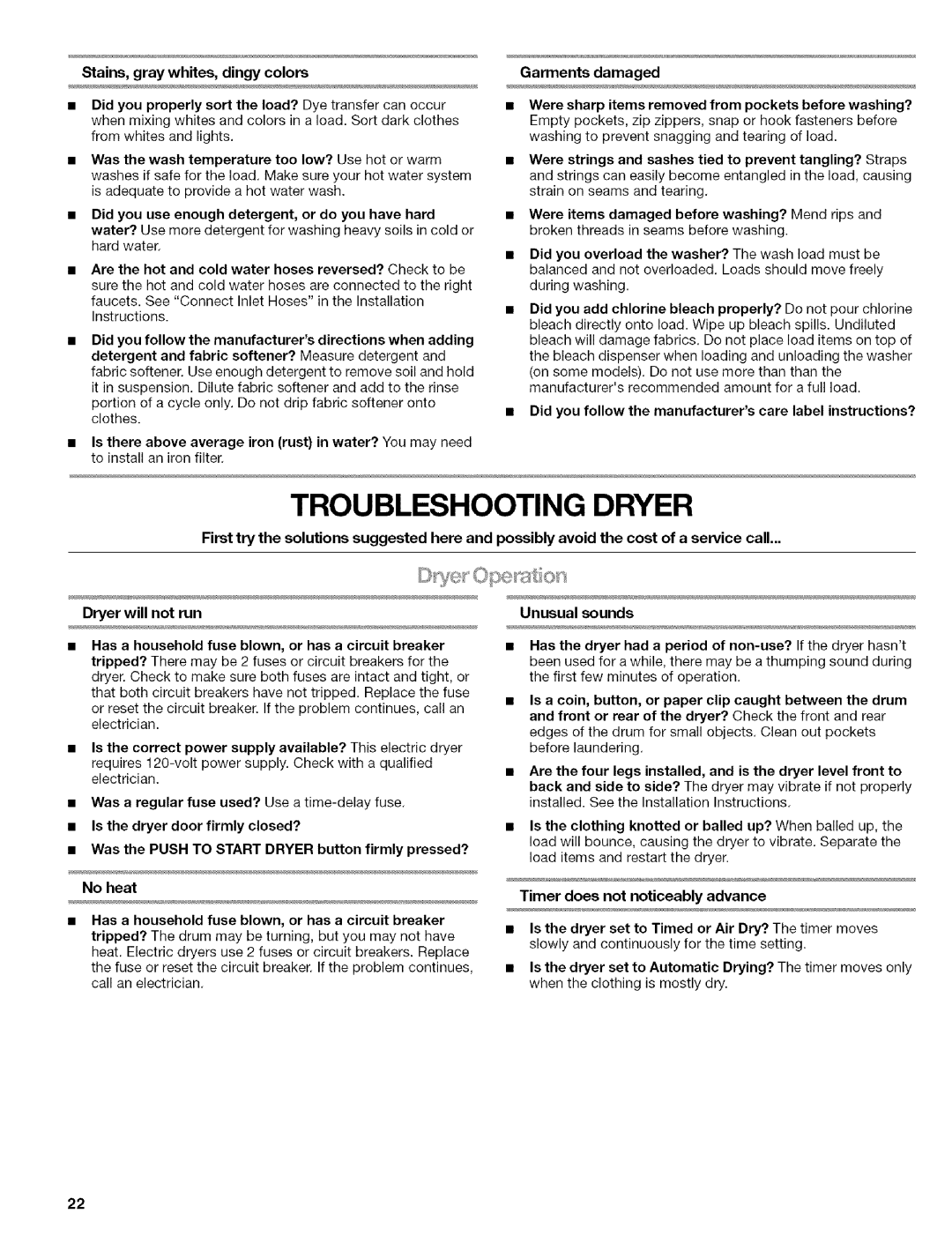
Stains, gray whites, dingy colors
•Did you properly sort the load? Dye transfer can occur when mixing whites and colors in a load. Sort dark clothes from whites and lights.
•Was the wash temperature too low? Use hot or warm washes if safe for the load, Make sure your hot water system is adequate to provide a hot water wash.
•Did you use enough detergent, or do you have hard water? Use more detergent for washing heavy soils in cold or hard water.
Are the hot and cold water hoses reversed? Check to be
sure the hot and cold water hoses are connected to the right faucets. See "Connect Inlet Hoses" in the Installation Instructions.
Did you follow the manufacturer's directions when adding detergent and fabric softener? Measure detergent and fabric softener. Use enough detergent to remove soil and hold
it in suspension. Dilute fabric softener and add to the rinse portion of a cycle only. Do not drip fabric softener onto clothes.
•Is there above average iron (rust) in water? You may need to install an iron filter.
Garments damaged
•Were sharp items removed from pockets before washing? Empty pockets, zip zippers, snap or hook fasteners before washing to prevent snagging and tearing of load.
•Were strings and sashes tied to prevent tangling? Straps and strings can easily become entangled in the load, causing strain on seams and tearing,
•Were items damaged before washing? Mend rips and broken threads in seams before washing.
•Did you overload the washer? The wash load must be balanced and not overloaded. Loads should move freely during washing.
Did you add chlorine bleach properly? Do net pour chlorine bleach directly onto load. Wipe up bleach spills. Undiluted bleach will damage fabrics, Do not place load items on top of the bleach dispenser when loading and unloading the washer (on some models), Do not use more than than the manufacturer's recommended amount for a full load.
•Did you follow the manufacturer's care label instructions?
TROUBLESHOOTING DRYER
First try the solutions suggested here and possibly avoid the cost of a service call...
Dryer will not run | Unusual sounds |
Has a household fuse blown, or has a circuit breaker tripped? There may be 2 fuses or circuit breakers for the dryer. Check to make sure both fuses are intact and tight, or that both circuit breakers have not tripped. Replace the fuse or reset the circuit breaker. If the problem continues, call an electrician.
•Is the correct power supply available? This electric dryer requires
•Was a regular fuse used? Use a
•Is the dryer door firmly closed?
•Was the PUSH TO START DRYER button firmly pressed?
•Has the dryer had a period of
Is a coin, button, or paper clip caught between the drum and front or rear of the dryer? Check the front and rear edges of the drum for small objects, Clean out pockets before laundering.
•Are the four legs installed, and is the dryer level front to back and side to side? The dryer may vibrate if not properly installed. See the Installation Instructions,
•Is the clothing knotted or balled up? When balled up, the load will bounce, causing the dryer to vibrate. Separate the load items and restart the dryer.
No heat
Has a household fuse blown, or has a circuit breaker tripped? The drum may be turning, but you may not have heat. Electric dryers use 2 fuses or circuit breakers. Replace the fuse or reset the circuit breaker. If the problem continues, call an electrician.
Timer does not noticeably advance
•Is the dryer set to Timed or Air Dry? The timer moves slowly and continuously for the time setting.
•Is the dryer set to Automatic Drying? The timer moves only when the clothing is mostly dry.
22
